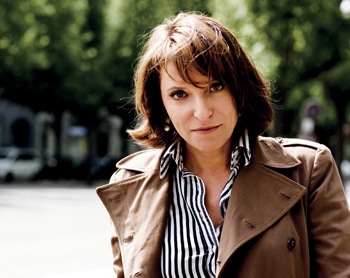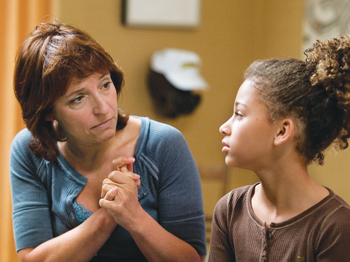By Margy Rochlin

INTERNATIONAL: A character in a Bier film can cask a question in Danish
and get an answer in English, German or Swedish.
Although Danish filmmaker Susanne Bier spent five years making short films and dissecting film theory at Copenhagen’s prestigious National Film School of Denmark, it was her comfort in the often mathematical world of construction and design, acquired while studying architecture at the Architectural Association in London, that she believes made the task of directing feature films less daunting for her.
“In a way the whole notion of a blueprint of a building is not that different from a script for a movie,” says Bier, who over the course of her career has made 11 movies including In a Better World, a drama-thriller set in an unnamed Danish town and a refugee camp in Africa, which won the Oscar for best foreign language film in 2011. “A sequence of spaces, which is what you do as an architect, is really the same as a sequence of scenes. As a director what you’re doing can be very detailed and specific in very definite areas. And at all times you need to understand the entire image. I think in that way, being trained as an architect has helped me a lot.”
In Hollywood, Bier is regarded as a moviemaker from Denmark. Yet the truth is more complicated than that: Dialogue in a Bier film tends toward the international where a character can ask a question in Danish and be answered in English, German, or Swedish. So in 2007, when she directed Things We Lost in the Fire, her first film for a studio with a cast of American stars—Halle Berry, David Duchovny, and Benicio Del Toro—she was already accustomed to hearing non-Danish spoken on her set. “I don’t feel I have an issue with listening or understanding English in any sort of way,” says Bier, whose family fled Germany during World War II and ended up settling in New York City and London. “I think it’s because of being Jewish and having family from all over the place. I’ve been speaking English since I was a kid. More important, English has always been my first language in terms of reading.”
Since her directorial debut in 1991, a light romantic comedy called Freud Leaving Home, Bier’s movies have flipped between romps and more somber fare. What is instantly recognizable, though, is one of her cinematic signatures: an almost painterly, heavily saturated color palette. “I have this thing with coloring,” says Bier, who thinks of her style as a reaction to those Nordic directors who like films that look gloomy. “There were 10 or 15 years where all the Scandinavian movies were gray and light brown. I got really bored with it. I really felt that movies had to have that life of vivid colors.”
To that end, Bier often likes to establish a soft-focus landscape of earth tones (golds, tans, pale greens) as a backdrop so that bursts of color—a child’s shocking pink parka, a turquoise door faded by weather, the bright yellow of a liquor bottle label—vibrate in the foreground. Be it her Oscar-nominated After the Wedding (2006), which unfolds, in part, in an orphanage in Mumbai, India, or her domestic drama and first film made for an American studio, Things We Lost in the Fire, Bier has been able to use wardrobe, set design, and scenic locations to get her trademark look. If necessary, she accentuates the contrast in postproduction.
The challenging part, then, is that she has to constantly reinvent how to get her meticulously selected hues to read properly on the screen because she likes using different cameras on every project. “In a Better World is shot on RED. The movie I just shot”—a romantic wedding comedy starring Pierce Brosnan called All You Need Is Love—“was shot on an Alexa,” says Bier, who has also experimented with high-def as well as a heat-sensitive infrared camera. “So every time we’ve had to get it in a different manner. But we’ve been trying to get to that point of very rich coloring.”
Talk to Bier for a couple of hours and it would be easy to assemble a list of her cinematic likes and dislikes. She prefers the immediacy that comes with a roaming handheld camera and despises filming in the middle of the day. “I hate when the sun is high and there are no shadows,” says Bier, a lover of natural light. “If I could do super high-budget movies I would only shoot when the sun starts to get low—but you can’t just shoot for four hours every day.”
Though most of her movies are set in Denmark, her penchant for scripts with subplots in far-flung locations has taken her everywhere from the parched beige desert terrain of Afghanistan to Sorrento, Italy’s picturesque coastline. “A great location delivers the free gift of a natural mise-en-scène,” says Bier. “I always feel like when I work on the stage it’s much less organic."

CHILD'S PLAY: Bier believes in treating kids in her films the same way she treats adults. "Respect and expectation work."
And then there’s how she deals with her cast. Her trick for teasing out affecting, naturalistic performances from her child actors is all about her preference for casting the sort of youngster who doesn’t mind sticking tightly to the script when it comes to dialogue and is open to physical improvisation. “Basically in movie-making, as in life,” says Bier, “I just believe in integrating kids, in treating them the same way you do adults. Of course they don’t understand the same kind of language. There are certain words they won’t understand and you have to change your wording. But respect and expectation work.”
Bier uses extreme close-ups, isolating a facial expression or body movement—a nervous mouth, pain flickering in a woman’s eyes, a hand grabbing a woman’s derrière and giving it a playful squeeze—to underscore the drama of the moment. After years of examining this footage in the editing room, Bier has perfected a system for how to direct her actors in these emotion-heighteners: After a scene is finished filming, but before moving on to the next, she shoots the actors repeating key gestures, almost in slow motion. “I don’t consider the scene finished until I’ve done this,” says Bier. “I don’t consider it extra material. It’s just as much part of shooting the scene—it’s just done at the very end. I consider it a completely integrated part of covering the scene.”
Bier had made six Danish movies before her first commercial success in Europe, a romantic comedy about two couples in disintegrating marriages called The One and Only (1999). Since then she’s gained a reputation in Europe as a hit-maker, as someone who releases films that reliably generate ticket sales at the box office. Back home her popularity has meant often being taken to task for not being edgy enough, but Bier doesn’t think of it that way. “It’s easier making commercially less promising movies in Europe than it is in America because Europe has a strong system of subsidizing movies,” she says. “A lot of quite boring self-indulgent movies are being made in Europe because they’re supposed to be ‘artistic.’ ”
So as soon as All You Need Is Love is completed, Bier has plans to make another American feature. She learned from making Things We Lost in the Fire, as well as from having her 2004 war drama Brothers remade by Jim Sheridan, what it’s like to reach the masses as only a Hollywood-produced film can. “Of course you want to do English language films,” says Bier, who in joining the DGA in 2006 found it made her feel more a part of the moviemaking community. “My movies have been very successful in Europe. But if you feel that you’ve got some stories to tell which are going to interest, amuse, or entertain, you want to address a bigger audience.”